Human papillomavirus (HPV) affects epithelial cells and has a particle diameter of 55 nm. A special feature is the proliferation of skin epithelium and mucous membranes. At the initial stage, the pathogen usually affects the basal cells of the epithelium, entering them through microtraumas. Localized papillomas are usually found on the skin of the neck, arms, groin and genitals (most often), oral mucosa and nasopharynx.
This virus can exist for many years without symptoms. To detect HPV, electron microscopic or molecular hybridization methods are used.
Types of human papillomavirus
In humans, there is HPV that affects mucous membranes and skin. Among the large number of papillomaviruses, there are species with low and high oncogenic risk. It has been proven that oncogenic properties are related to the ability to integrate DNA into the genome of human cells.
The virus is activated in 10-20% of cases. Depending on its type, it can cause benign or malignant lesions. Some HPVs are not oncogenic. They cause warts and genital warts. HPV 6 and 11 are the most common.
HPV oncogenes are those that have a high risk of developing cancerous lesions, especially on the cervix or anus. As for the skin, HPV 16 and 18 are more common, as well as 5 and 8, which can cause skin cancer. The most well-known form of cancer caused by HPV is cervical cancer. But men can also be infected with the papilloma virus, which in the worst case causes cancer of the penis or anus.
Often women encounter HPV 16 - this is the form in which intrasomal parasitism is observed, that is, outside the chromosome of the cell (benign). HPV 18 has a high risk of developing cancer – first benign tumors are formed, which after some time degenerate into cancer. In this case, virions have small sizes (up to 30 nm).
- cervical neoplasms;
- invasive or pre-invasive oncology;
- Genital warts of the urinary tract and genitals.
Characteristics of the infection

Human papillomavirus is highly contagious. It is usually transmitted by direct contact with an infected person, skin-to-skin or mucous-to-mucosal. In the case of genital infection, this most often occurs during vaginal or oral intercourse. Having a large number of sexual partners or other STIs (sexually transmitted infections) increases the risk. Indirect transmission through objects, contaminated clothing or bed linen is also possible, but is quite rare.
In 7% of cases, transmission of the virus from mother to child can occur during childbirth, when the infection is active. The risk increases to 40% if infected with HPV 16 or 18.

Penetrating the epithelium, breaking its integrity, papillomavirus infection promotes the growth of the lower layer of epithelial cells in the form of condylomas or warts. This form of the disease is contagious and spreads quickly to others. As a rule, warts and condylomas do not cause metastases and often disappear spontaneously.
HPV symptoms
The incubation period lasts up to 9 months (3 months on average). HPV can be in the body without obvious symptoms. The virus can go undetected for months or years. Even at this stage it is contagious.
Skin warts usually appear in groups and increase in number when scratched. The two most common forms of papillomas are gray, hard, with a broken surface (common wart) or flat and reddish (flat wart). Prickly warts appear on the soles or heels of the feet, grow inward, and are therefore often painful.
- Genital warts. Pale or reddish nodules that often appear in groups and appear on the labia, vagina, penis, urethra, anus, and rectum. They are highly contagious.
- Flat condylomas. They appear as flat nodules and are found mainly on the female genital organs. They increase the risk of developing cancer.
- Giant condylomas (Buschke-Lewenstein tumors). They grow in huge formations, destroying the surrounding tissues. In rare cases, they can degenerate into squamous cell carcinoma.
Infection of the mucous membrane of the upper respiratory tract is also possible. The conjunctiva of the eye may be damaged, resulting in the formation of pink stalked growths.
It is more difficult to detect the asymptomatic course, which the doctor can only see with aids such as acetic acid (causes the warts to change color) or with a microscope.
In addition, the virus can also settle in cells without tissue changes. Then they talk about latent infection, that is, the presence of pathogens, but without symptoms. After infection, this stage can last from several weeks to several months.
possible outcomes
When infected, viruses penetrate into the cells of the entire tissue of the skin and mucous membrane, settle in the nuclei of cellular structures and multiply there. As a rule, such HPV infections remain unnoticed and heal themselves without consequences, because the immune system successfully fights the pathogen.
However, some types of HPV cause skin changes called growths. Possible forms are genital warts or condylomas and papillomas, which can affect, for example, the face, arms or legs.
The resulting tissue changes are mostly benign, but can also degenerate and lead to cancer. For example, cancer can occur decades after an HPV infection. Cancers of the female external genitalia (cancer of the vulva and vagina), anal cancer, penile cancer, and mouth and throat cancer (tumors of the head and neck) are also possible.
Establishing a diagnosis

In women, the test for HPV infection is carried out as part of preventive visits to the gynecologist. During a gynecological examination, a smear is taken from the mucous membrane of the cervix, this is called a Papanicolaou test (cytological examination). The resulting material is studied for tissue changes to determine precancerous conditions.
In addition, an HPV test may be performed, in which cellular material from a mucosal smear or tissue sample is tested in a laboratory for the presence of certain viruses. However, this only confirms that the affected area is infected, but does not make any statement as to whether tissue changes have occurred. Thus, an HPV test makes sense, especially when combined with a Pap test, and can help detect early precursors of cancer.
If the test is positive, there is no reason to worry, because infections do not always lead to cancer. Regular examination is recommended to detect tissue changes at an early stage. Conversely, a negative test result does not indicate whether there was a past infection that the body successfully fought.
For men, there is no preventive examination in which the test will be carried out regularly. If an underlying cancer is present, testing the tumor can determine whether an HPV infection is at the root of the cancer.
Specialized DNA methods are also used in laboratory diagnostics, such as real-time PCR. Anogenital warts caused by HPV types 6 and 11 are easily detected during a gynecological examination.
How to cure human papillomavirus
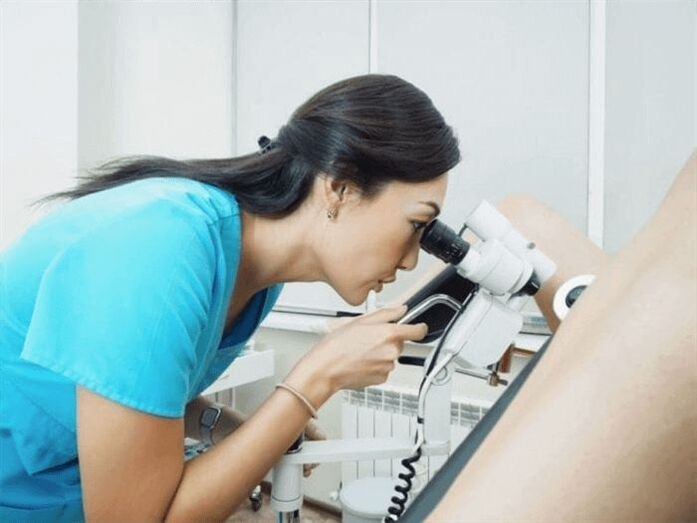
In most cases, the disease does not require treatment, because it goes away by itself, and then the viruses are no longer detected. However, if this is not the case, the infection may last longer and last for months or years.
To date, there are no methods of systemic exposure to this virus that could completely destroy it. However, treating the existing warts reduces the number of viruses, so in many cases the immune system can fight the remaining viruses and get rid of them. In some cases, pathogens survive and can cause disease symptoms again and again.
- Plantar and genital warts can be treated with salicylic acid topical medications.
- Cryotherapy is also a method often used for HPV. In this case, the wart is burned with cold, using liquid nitrogen.
- Equally used methods are lasers or electrocautery.
Cancer caused by HPV is much more difficult to treat. In the case of cervical cancer, it is often advisable to remove the uterus, followed by the upper part of the vagina and ovaries. This can be combined with radiation therapy to eliminate the possibility of recurrence. Other cancers caused by HPV are most often treated with targeted therapy, such as radiation or chemotherapy.
It should be remembered that surgery is not a radical solution, but only solves a cosmetic problem, since after removal, the virus can remain in the surrounding tissues and condylomas can appear again.
Prevention of infection
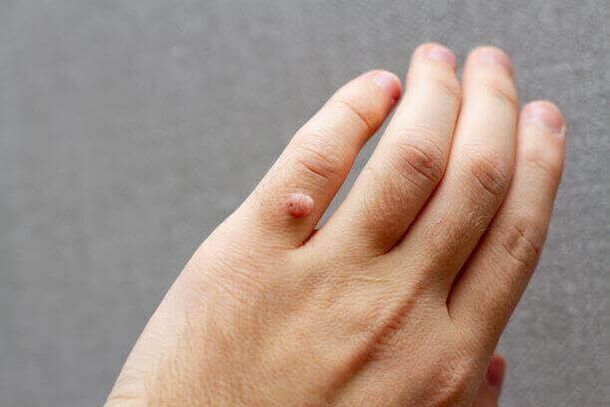
There are two vaccinations: the bivalent vaccine against HPV 16 and 18 and the quadrivalent vaccine against HPV 6, 11, 16 and 18. Vaccination is recommended for all young girls age 14 and older.
Vaccination does not protect against all types of HPV. Therefore, all women between the ages of 25 and 65, even if vaccinated, are recommended to undergo regular smear examinations.
Timely detection and complete removal of condyloma reduces the risk of the disease. The effectiveness of using condoms to protect against transmission of infection can significantly reduce the risk of developing this disease. The most promising way to prevent and treat the initial stages of the disease caused by this infection is a specific polyvalent vaccine.
Why plantar warts appear and treatment methods
Warts are skin lesions that appear as special round growths raised above the surface. They are caused by specific viruses.
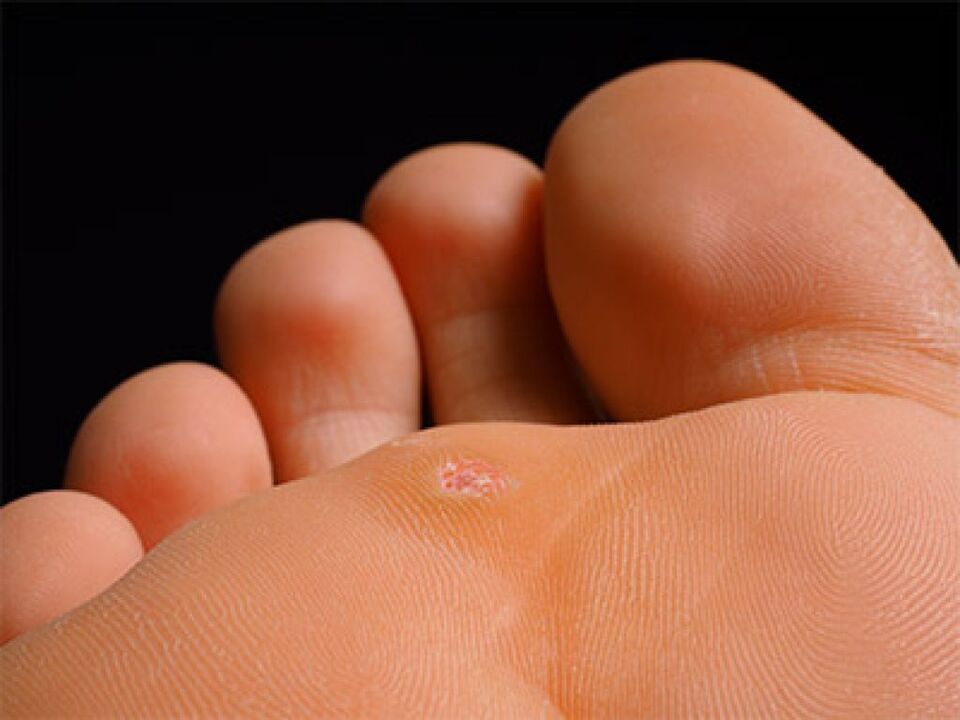
These formations often cause physical discomfort due to their location. Even after treatment, they will recur.
Types and causes
There are many types of warts, they are classified according to a number of characteristics:
- easy. They are found on exposed parts of the body, arms, legs, face and scalp. They are usually not dangerous, but they are not aesthetically pleasing and can multiply quickly, affecting large areas of skin. They are arranged as if in "families".
- plantar. Their localization is exclusively on the legs. causes discomfort while walking.
The main cause is human papillomavirus infection, which affects the mucous membrane and skin.
Human papillomavirus
It is one of the most common viruses on earth. Infection can occur in several ways:
- contact and household (by touch);
- sexual (genital, anal, oral-genital);
- From mother to child during childbirth.

The period of development of the disease ranges from a few weeks to tens of years, this is explained by the fact that the virus may not be detected for a long time, but as soon as the immunity weakens a little, growths appear immediately. skin and/or mucous membranes. The main danger of this disease is that certain types of HPV are most likely to cause the formation of malignant tumors (cancer of the skin or mucous membranes). In order to make sure that the disease does not lead to the formation of cancer, it is necessary to undergo a doctor's examination and not to self-medicate.
Symptoms and types of warts on the feet
A plantar wart appears as a callus-like thickening along the stratum corneum of the skin. It interferes with walking and causes pain. The passive state is characterized by slow reproduction, does not reach the corneal layer of the epithelium, so this state is not manifested externally.
The active state is characterized by the fact that the virus develops rapidly and, rising to the upper layers of the epidermis, manifests itself with many symptoms. Plantar warts are also called warts, chicken warts. During contact with the skin, the virus enters through cuts and abrasions of the outer layer of the skin:
- First, a small yellowish-gray papule with an uneven surface appears.
- Gradually, the small element becomes dense and acquires a dirty color.
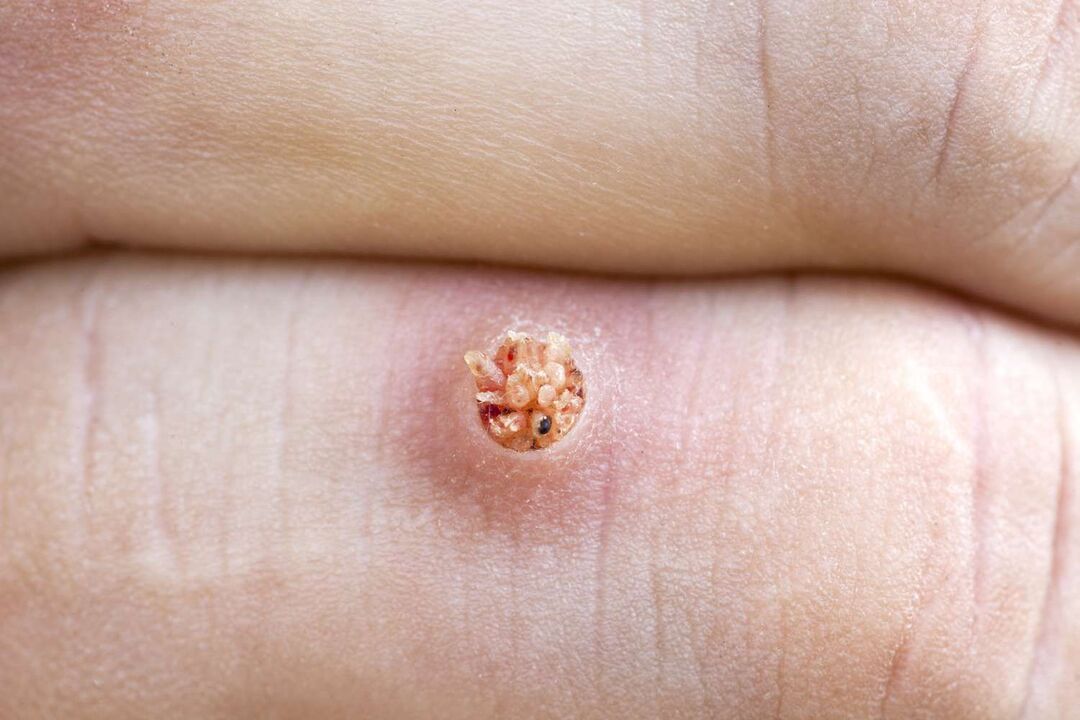
From the inside, a plantar wart looks like a fused papilla of various sizes with a pinkish tint. Additional capillary blood vessels are formed there, which cause bleeding if the wart is pinched.
Removal of plantar warts
Plantar warts should be treated if:
- There are painful sensations.
- The wart is bleeding.
- There were spots on it.
- Warts grow rapidly.
There are many methods of treatment. One of them is cryodestruction. The importance of the method is that the wart is exposed to liquid nitrogen at a temperature of minus 196 degrees. The area affected by the virus is frozen and the wart is removed.
A conventional and aggressive method of exposure is used. The aggressive method uses nitrogen for a few seconds longer, but this method is more painful. It is important to note that if a wart appears and exists for more than six months, then the effectiveness of cryodestruction is significantly reduced and, therefore, the value of such an operation disappears.
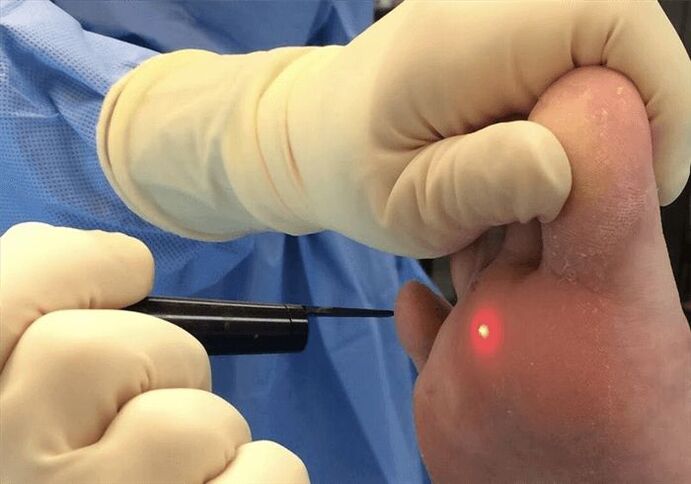
After removing a plantar wart using liquid nitrogen, you should follow some recommendations:
- The blister left at the site of the wart cannot be opened;
- To avoid mechanical damage, use a sterile bandage, not a plaster;
- treatment of the affected area with salicylic alcohol 2% twice a day;
- Try to avoid water on the affected area.
Another method is laser coagulation. This is one of the most common methods of removing warts. Most laser systems are equipped with a special cooling system. Thus, the procedure takes place with minimal discomfort and does not cause inflammation, since the laser has antiseptic properties. Moreover, it is a non-contact method.
There are several ways:
- Carbon dioxide (CO2) laser. Treatment in this case is done using infrared light. The method is 70% effective, but the downside is that healthy tissue can also be damaged.
- Erbium laser. This treatment method uses shorter wavelengths, which reduces the likelihood of scarring after surgery. Efficiency is usually 75%.
- Pulsed dye laser. With this method of exposure, primary destruction of expanded capillaries in warts and stimulation of the immune system, which contributes to effective healing. Treatment efficiency is about 95%.
After laser treatment, a crust forms on the affected area, which disappears by itself in seven to ten days. The recommendations for this method of treatment are the same as after exposure to nitrogen - avoid mechanical damage and water ingress.
The next way to remove warts is electrocoagulation. In this case, a high-frequency current is applied to the wart. Treatment is performed under local anesthesia. Exposure of the wart to high temperature leads to vaporization of cells affected by the papilloma virus. Another advantage of this method is that cauterization of blood vessels prevents bleeding. After the operation, a crust is formed on the damaged area of the skin, which disappears in 7 to 10 days.
Plantar warts can be treated with direct surgery. In this case, excision is performed under local anesthesia, then stitches are placed. After the operation, the doctor will prescribe certain recommendations. Therefore, it is recommended to prevent the penetration of water and soap into the damaged area, not to apply the resulting crust and to treat the damaged area with an antiseptic during the first 7-10 days.
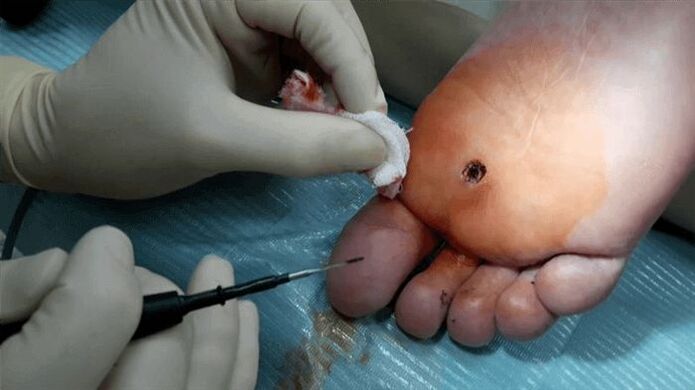
Each type of operation has certain contraindications. Therefore, it will not be possible to perform the operation if the following occurs:
- pregnancy;
- diabetes;
- malignant tumors in the body;
- Infection and inflammation around the wart;
- exacerbation of herpes;
- elevated temperature.
If your blood pressure is high, the procedure should also be delayed.
Treatment of warts without surgery
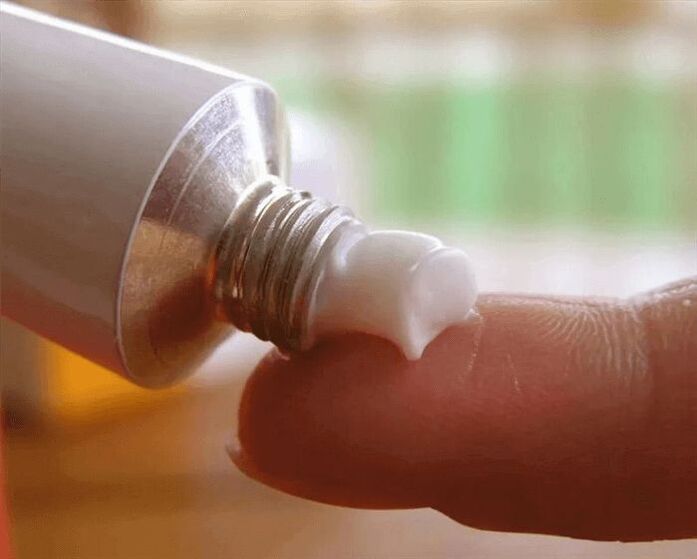
People often wonder how to remove plantar warts without surgery. For this, you can use pharmaceutical ointments and solutions.
Basically, these ointments have the following effects:
- anti-inflammatory;
- antiseptic;
- immunomodulatory;
- antivirus;
- anti-fungal.
In addition, it may contain vitamin E, which also has a positive effect on treatment, since vitamins generally strengthen the body and reduce the risk of relapse.
Importantly, these products should be used for single and superficial plantar warts. Moreover, in case of any side effects, it is necessary to wash off the medicine with plenty of warm water and consult a doctor immediately.
So warts can be cured, there are many ways to do it, but you should not do it without first consulting a doctor, so as not to harm your health. In addition, self-medication is strictly prohibited if the attending physician prescribes contraindications.
Treatment of papillomas on the body
hardware methods
Modern equipment methods of treating papillomas make it possible to get rid of them and prevent the recurrence of the disease. The most commonly used methods are:
- Cryodestruction is the destruction of formations by exposure to low temperatures.
- Electrocoagulation is burning formations with an electric current, the strength and frequency of which is selected depending on the size, type and density of the papilloma.
- laser removal. The type of impact is obvious from the name. The procedure lasts no more than 15 minutes and helps to get rid of unpleasant formations forever.
Drug treatment
Among the medicines used are celandine, castor oil, lapis pencil, Sani Skin and Dermavit preparations.
They show different effectiveness and do not prevent the recurrence of the disease. The main disadvantage of drug therapy for papillomas is the frequent development of allergic reactions.
Prevention of papillomas
To prevent growths and prevent infection with human papillomavirus, you should:
- Use barrier contraception during intercourse.
- Follow the rules of personal hygiene and use only individual towels, soap and toothbrush.
- Do not forget to wear rubber shoes when visiting public baths.
You should also adjust your daily routine, eat a balanced diet, give up bad habits and avoid stressful situations. These factors are not the cause of the disease, but can provoke its development if the virus is already present in the body.














































































